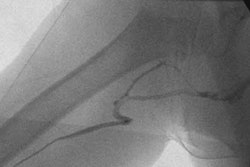NEW ORLEANS - Using focal cryoablation, interventional radiologists in Florida have performed a "male lumpectomy," designed to target and treat prostate cancer while sparing healthy tissue.
During his presentation Friday at the Society for Interventional Radiology (SIR) meeting, Dr. Gary Onik pointed out that prostate cancer literature "shows that 20% to 25% of prostate cancers are one-lesion cancers, while 60% are two-lesion cancers, with each lesion under 5 cm."
As a result, most prostate cancer can be treated with nerve-sparing cryoablation, he said. Currently, whole-prostate cryoablation is the only Medicare-approved treatment for patients in whom radiation therapy has failed.
Onik is from Florida Hospital Celebration Health in Celebration, FL. His group treated 64 patients with focal cryoablation therapy. Seventeen of the 64 had a medium to high Gleason score, while four were radiation failures, he said.
All patients underwent transrectal ultrasound (TRUS) biopsy to exclude cancer on healthy gland. Onik checked prostate-specific antigen (PSA) levels every three months for two years and every six months thereafter. In addition, the first 19 patients had another biopsy at one year. He reported long-term results for 42 patients who were followed for at least one year.
Forty of the 42 patients had no evidence of cancer based on stable PSA tests. Thirty-eight patients were biologically disease-free, according to criteria set by the Fairfax, VA-based American Society of Therapeutic Radiology and Oncology (ASTRO). Three patients required additional cryoablation for cancer in another gland.
More important, 25 of the 32 men who reported normal sexual function before treatment maintained potency after treatment. And there were no reports of either urinary or rectal incontinence, Onik said. Preserving both sexual and urinary function is a major advantage of this lumpectomy approach, he added.
"This is very different from whole-gland cryoablation -- if I ablate the whole gland, the patient will be impotent. That is, in fact, a criteria for successful ablation," he explained.
"A urologist will tell you that you have to treat the whole gland because every patient has multifocal disease, but if you look at the pathology that is not true. You can get excellent results by treating just the tumor."
Moreover, unlike brachytherapy, there are "a wide range of patients who can benefit from this treatment. Brachytherapy is only good in patients with low Gleason scores," he said.
One of the keys to a successful male lumpectomy is careful restaging of the cancer with 3D global mapping biopsies, according to Onik. "We map the gland every 5 mm for the gland length, which gives us about 30 cores," he said.
"I believe that focal cryoablation can change the paradigm of treatment for prostate cancer in much the same way that lumpectomy changed the paradigm of treatment for breast cancer," Onik concluded.
By Peggy Peck
AuntMinnie.com contributing writer
April 4, 2005
Related Reading
Prostate radiotherapy raises risk of rectal cancer, April 1, 2005
Ethnicity, marital status affects treatment decisions in prostate cancer, March 29, 2005
Brachytherapy for prostate cancer yields good long-term results, March 14, 2005
Percutaneous cryoablation reduces pain in patients with advanced cancer, March 8, 2005
Copyright © 2005 AuntMinnie.com



















